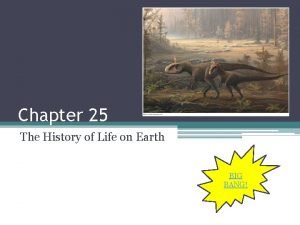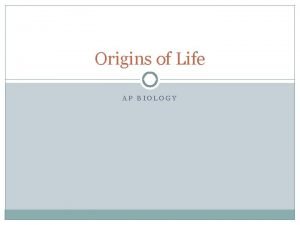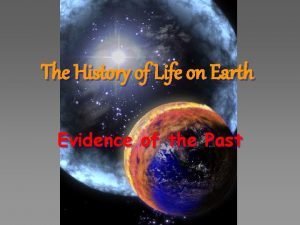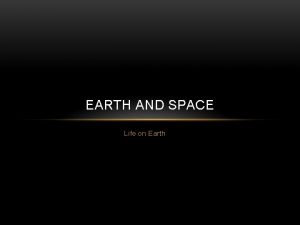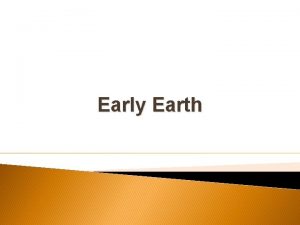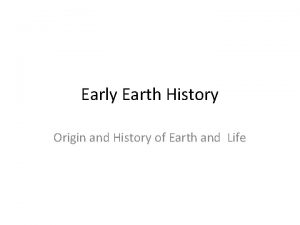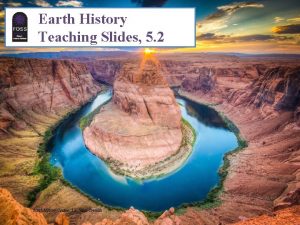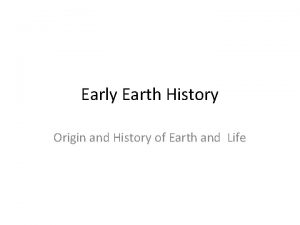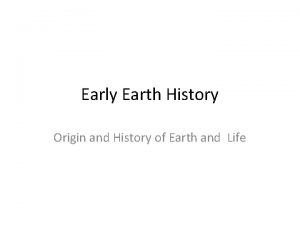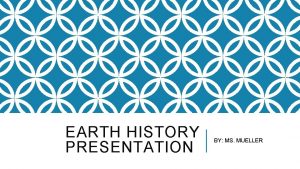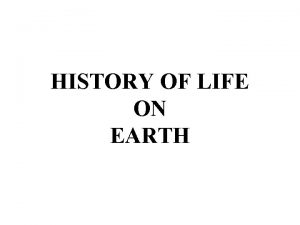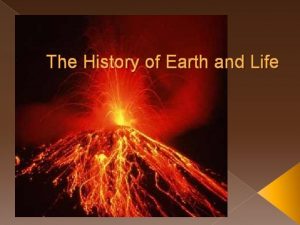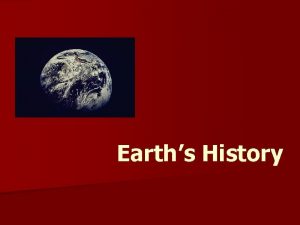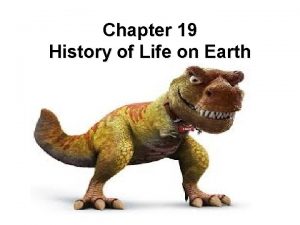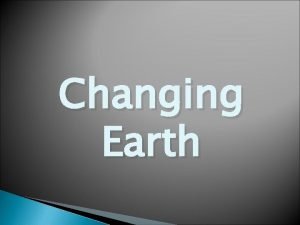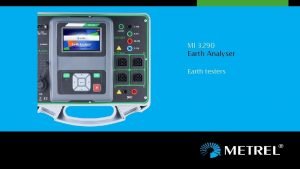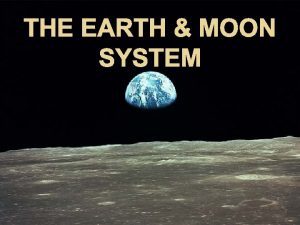Chapter 25 The History of Life on Earth





































- Slides: 37

Chapter 25 The History of Life on Earth BIG BANG!

What you need to know: • 1) A scientific hypothesis about the origin of life on Earth. • 2) The age of the Earth and when prokaryotic and eukaryotic life emerged. • 3) Characteristics of the early planet and its atmosphere. • 4) How Miller & Urey tested the Oparin-Haldane hypothesis and what they learned. • 5) Methods used to date fossils and rocks and how fossil evidence contributes to our understanding of changes in life on Earth. • 6) Evidence for endosymbiosis. • 7) How continental drift can explain the current distribution of species (biogeography) • 8) How extinction events open habitats that may result in adaptive radiation.

Early conditions on Earth

• Earth = 4. 6 billion years old • First life forms appeared ~3. 8 billion years ago How did life arise? 1. Small organic molecules were synthesized 2. Small molecules macromolecules (proteins, nucleic acids) 3. Packaged into protocells (membrane-containing droplets) 4. Self-replicating molecules allow for inheritance “RNA World”: 1 st genetic material most likely RNA First catalysts = ribozymes (RNA)

Origin of Organic Molecules Electrodes discharge sparks (lightning simulation) • Abiotic synthesis ▫ 1920 Oparin & Haldane propose reducing atmosphere hypothesis Water vapor CH 4 NH 3 Mixture of gases ("primitive atmosphere") H 2 Condenser Water Heated water ("ocean") Condensed liquid with complex, organic molecules

Synthesis of Organic Compounds on Early Earth • Oparin & Haldane: ▫ Early atmosphere = H 2 O vapor, N 2, CO 2, H 2 S methane, ammonia ▫ Energy = lightning & UV radiation ▫ Conditions favored synthesis of organic compounds - A “primitive soup”

Origin of Organic Molecules Electrodes discharge sparks (lightning simulation) • Abiotic synthesis ▫ 1920 Oparin & Haldane propose reducing atmosphere hypothesis Water vapor CH 4 NH 3 Mixture of gases ("primitive atmosphere") ▫ 1953 Miller & Urey test hypothesis H 2 Condenser Water formed organic compounds amino acids adenine Heated water ("ocean") Condensed liquid with complex, organic molecules

Creating the Potential for Life Miller & Urey: • Tested Oparin-Haldane hypothesis • Simulated conditions in lab • Produced amino acids

Stanley Miller University of Chicago produced -amino acids -hydrocarbons -nitrogen bases -other organics Why was this experiment important? ? ! What was the Miller Urey Experiment? (7: 29)

Key Events in Origin of Life • Origin of Cells (Protobionts) ▫ lipid bubbles separate inside from outside metabolism & reproduction • Origin of Genetics ▫ RNA is likely first genetic material ▫ multiple functions: encodes information (selfreplicating), enzyme, regulatory molecule, transport molecule (t. RNA, m. RNA) makes inheritance possible makes natural selection & evolution possible • Origin of Eukaryotes ▫ endosymbiosis

Protocells & Self-Replicating RNA

If life has to come from living things, how did life first start? ! https: //www. youtube. com/watch? v=d 4 VS 00 it 40 o Origin of Life – PBS NOVA

Fossil Record: used to reconstruct history • Sedimentary rock (layers called strata) • Mineralized (hard body structures) • Organic – rare in fossils but found in amber, frozen, tar pits • Incomplete record – many organisms not preserved, fossils destroyed, or not yet found

Cut to Video

Relative Dating Radiometric Dating Both used to date fossils and determine age • Uses order of rock strata to determine relative age of fossils • Measure decay of radioactive isotopes present in layers where fossils are found • Half-life: # of years for 50% of original sample to decay


Geologic Time Scale Eon Era Period Epoch (longest to shortest) Present Day: Phanerozoic Eon, Cenozoic Era, Quaternary Period, Holocene Epoch

Clock Analogy of Earth’s History

Key Events in Life’s History O 2 accumulates in atmosphere (2. 7 bya) Life Before Oxygen Humans (200, 000)

HHMI Biointeractive Click & Learn • Geological History of O 2 • Deep History of Life on Earth 1. In groups of 4, spend some time exploring the 2 click & learns using the planner provided. Each person does NOT need to fill out the entire chart…it is for information gathering ONLY. 2. Use the rubric create an “Outstanding” Poster. 3. Class presentation of posters. 4. Poster evaluations.

~2 bya First Eukaryotes • Development of internal membranes ▫ create internal micro-environments ▫ advantage: specialization = increase efficiency natural selection! infolding of the plasma membrane endoplasmic reticulum (ER) nuclear envelope nucleus DNA cell wall Prokaryotic cell Prokaryotic ancestor of eukaryotic cells plasma membrane Eukaryotic cell

1 st Endosymbiosis • Evolution of eukaryotes ▫ origin of mitochondria ▫ engulfed aerobic bacteria, but did not digest them ▫ mutually beneficial relationship natural selection! internal membrane system aerobic bacterium mitochondrion Endosymbiosis Ancestral eukaryotic cell Eukaryotic cell with mitochondrion

2 nd Endosymbiosis • Evolution of eukaryotes Eukaryotic cell with mitochondrion ▫ origin of chloroplasts ▫ engulfed photosynthetic bacteria, but did not digest them ▫ mutually beneficial relationship natural selection! photosynthetic bacterium chloroplast Endosymbiosis Eukaryotic cell with chloroplast & mitochondrion

Theory of Endosymbiosis • Evidence ▫ structural mitochondria & chloroplasts resemble bacterial structure mitochondria & chloroplasts have enzymes similar to living prokaryotes mitochondria & chloroplasts two membranes ▫ genetic mitochondria & chloroplasts have their own circular DNA & no histones (like bacteria) Lynn Margulis

Endosymbiont Theory Video Evidence functional • mitochondria & chloroplasts move freely within the cell • mitochondria & chloroplasts reproduce independently from the cell (binary fission) • mitochondria & chloroplasts have their own ribosomes to make proteins How Two Microbes Changed History Our favorite sisters here: https: //www. youtube. com/watch? v=FGn. S-Xk 0 Zq. U

Pangaea = Supercontinent • Formed 250 mya • Continental drift explains many biogeographic puzzles Video

Movement of continental plates change geography and climate of Earth Extinctions and speciation

POGIL: Mass Extinctions SHORTEST PERSON turn in your POGIL with sticky note

Mass extinctions Diversity of life • Major periods in Earth’s history end with mass extinctions new ones begin with adaptive radiations

Major events during each Era • Precambrian: microscopic fossils (stromatolites) ▫ Photosynthesis, atmospheric O 2 ▫ Eukaryotes (endosymbiont theory) • Paleozoic: Cambrian Explosion ▫ Plants invade land, many animals appear ▫ Permian Extinction (-96% species) • Mesozoic: “Age of Reptiles”, dinosaur, plants ▫ Formation of Pangaea supercontinent ▫ Cretaceous Extinction – asteroid off Mexico’s coast • Cenozoic: Primates Note: All end with major extinction & start with adaptive radiation

Discovery Education Video: Mass Extinction and Adaptive Radiation Running Time: 2: 25

Cambrian explosion • Diversification of Animals ▫ within 10– 20 million years most of the major phyla of animals appear in fossil record 543 mya


Evo-Devo: Evo-Devo evolutionary + developmental biology • Evolution of new forms results from changes in DNA or regulation of developmental genes

• Heterochrony: evolutionary change in rate or timing of developmental events Paedomorphosis: adult retains juvenile structures in ancestral species

• Homeotic genes: master regulatory genes determine location and organization of body parts • Ex: Hox genes Evolution of Hox genes changes the insect body plan. Hox gene expression and limb development.

Exaptations: Exaptations structures that evolve but become co-opted for another function ▫ Ex: bird feathers = thermoregulation flight
 Discovery education
Discovery education Aerobic bacteria
Aerobic bacteria Tuzo wilson
Tuzo wilson Chapter 17 the history of life
Chapter 17 the history of life Hát kết hợp bộ gõ cơ thể
Hát kết hợp bộ gõ cơ thể Lp html
Lp html Bổ thể
Bổ thể Tỉ lệ cơ thể trẻ em
Tỉ lệ cơ thể trẻ em Voi kéo gỗ như thế nào
Voi kéo gỗ như thế nào Chụp phim tư thế worms-breton
Chụp phim tư thế worms-breton Hát lên người ơi alleluia
Hát lên người ơi alleluia Các môn thể thao bắt đầu bằng tiếng chạy
Các môn thể thao bắt đầu bằng tiếng chạy Thế nào là hệ số cao nhất
Thế nào là hệ số cao nhất Các châu lục và đại dương trên thế giới
Các châu lục và đại dương trên thế giới Công của trọng lực
Công của trọng lực Trời xanh đây là của chúng ta thể thơ
Trời xanh đây là của chúng ta thể thơ Mật thư tọa độ 5x5
Mật thư tọa độ 5x5 Làm thế nào để 102-1=99
Làm thế nào để 102-1=99 độ dài liên kết
độ dài liên kết Các châu lục và đại dương trên thế giới
Các châu lục và đại dương trên thế giới Thể thơ truyền thống
Thể thơ truyền thống Quá trình desamine hóa có thể tạo ra
Quá trình desamine hóa có thể tạo ra Một số thể thơ truyền thống
Một số thể thơ truyền thống Cái miệng xinh xinh thế chỉ nói điều hay thôi
Cái miệng xinh xinh thế chỉ nói điều hay thôi Vẽ hình chiếu vuông góc của vật thể sau
Vẽ hình chiếu vuông góc của vật thể sau Thế nào là sự mỏi cơ
Thế nào là sự mỏi cơ đặc điểm cơ thể của người tối cổ
đặc điểm cơ thể của người tối cổ Thế nào là giọng cùng tên? *
Thế nào là giọng cùng tên? * Vẽ hình chiếu đứng bằng cạnh của vật thể
Vẽ hình chiếu đứng bằng cạnh của vật thể Phối cảnh
Phối cảnh Thẻ vin
Thẻ vin đại từ thay thế
đại từ thay thế điện thế nghỉ
điện thế nghỉ Tư thế ngồi viết
Tư thế ngồi viết Diễn thế sinh thái là
Diễn thế sinh thái là Các loại đột biến cấu trúc nhiễm sắc thể
Các loại đột biến cấu trúc nhiễm sắc thể Bảng số nguyên tố lớn hơn 1000
Bảng số nguyên tố lớn hơn 1000 Tư thế ngồi viết
Tư thế ngồi viết
